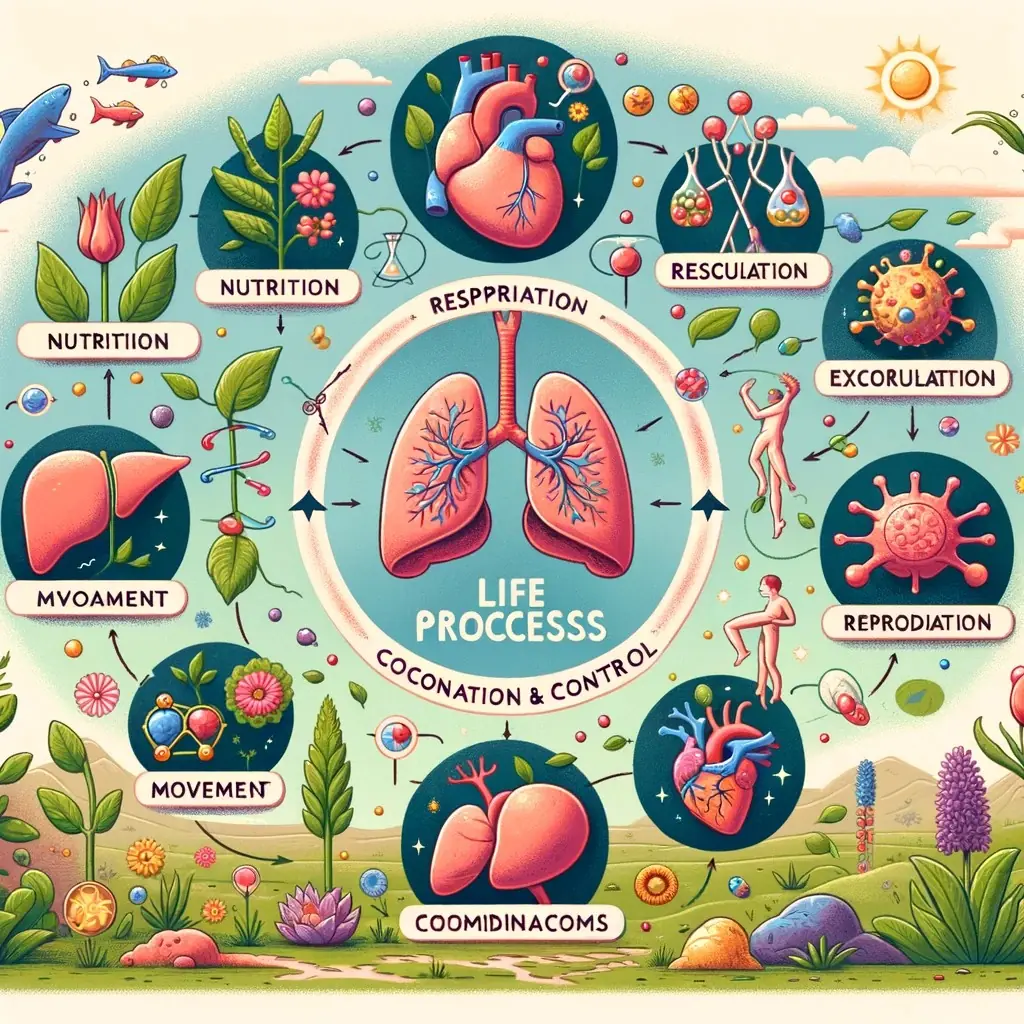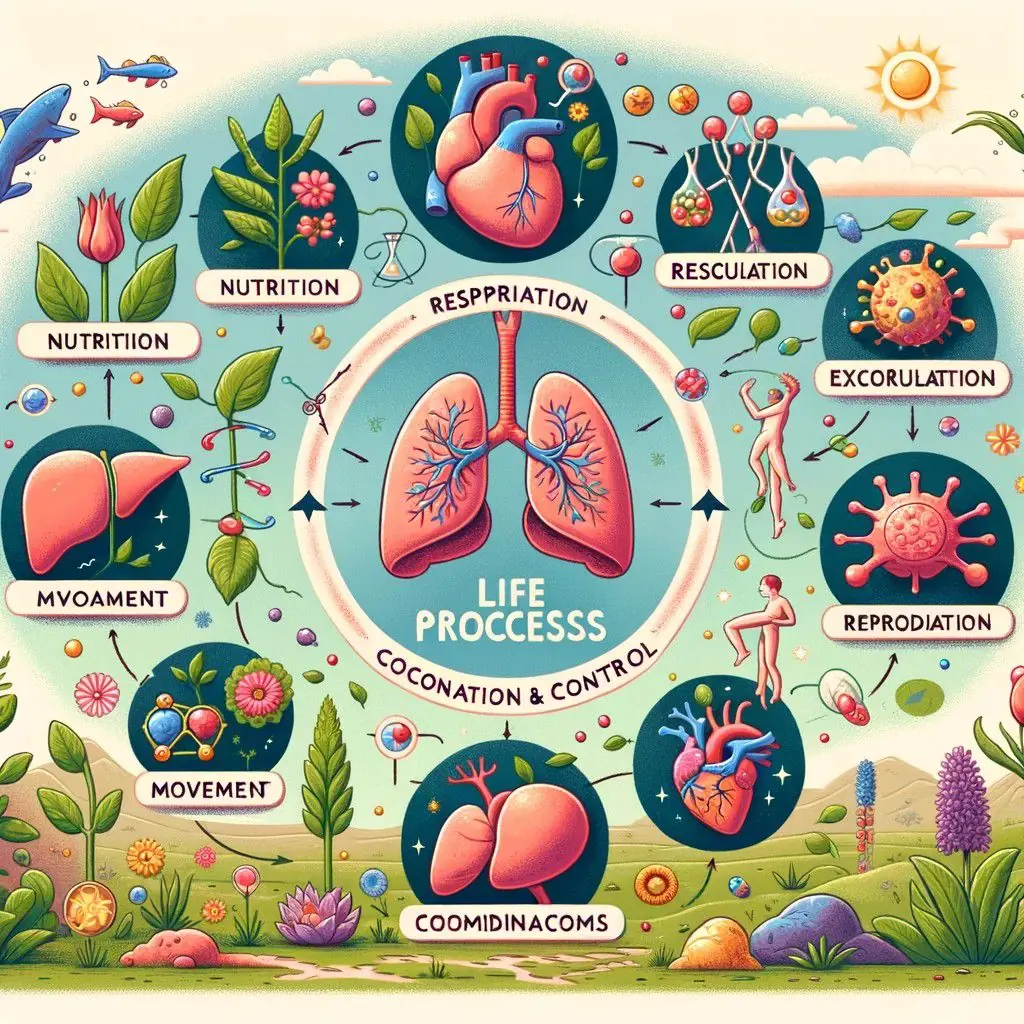
Exploring the Vital Life Processes: Nutrition, Respiration, Transportation, and Excretion in Living Organisms

Life Processes: A Comprehensive Guide for Class 10 Students
Introduction to Life Processes
The study of life processes is fundamental in understanding how living organisms function. This chapter aims to explore the various life processes essential for survival, growth, and reproduction in all living beings.
What Are Life Processes?
Life processes are the basic vital functions performed by living organisms to maintain their life. These include nutrition, respiration, circulation, excretion, movement, and reproduction. Each of these processes plays a crucial role in keeping an organism alive.
Nutrition: The Foundation of Life
Nutrition involves the intake of food and its conversion into energy and body-building materials. There are two types of nutrition:
- Autotrophic Nutrition: Where organisms like plants prepare their own food via photosynthesis.
- Heterotrophic Nutrition: Where organisms depend on others for food.
Respiration: The Powerhouse of Cells
Respiration is the process of breaking down food to release energy. It occurs in every cell and is vital for survival. Respiration can be aerobic (with oxygen) or anaerobic (without oxygen).
Circulation: The Transport System
Circulation involves the movement of substances within the body. The human circulatory system, consisting of the heart, blood, and blood vessels, transports nutrients, gases, and wastes.
Excretion: Waste Management in Organisms
Excretion is the process of eliminating waste materials from the body. In humans, the excretory system includes organs like kidneys, which remove urea and other wastes.
Movement and Locomotion: The Dynamics of Life
While movement refers to any change in position or place, locomotion is the movement of the entire organism from one place to another. Muscles and the skeletal system play key roles in these processes.
Reproduction: Continuing the Circle of Life
Reproduction is the biological process of producing new organisms. It can be asexual (involving a single parent) or sexual (involving two parents).
Coordination and Control: The Nervous and Endocrine Systems
These systems regulate and coordinate various functions and responses in the body. The nervous system includes the brain, spinal cord, and nerves, while the endocrine system comprises glands that secrete hormones.
Homeostasis: Maintaining Internal Balance
Homeostasis is the maintenance of a stable internal environment in an organism. It’s crucial for the optimal functioning of cells and, consequently, the organism’s survival.
Environmental Interaction: Adapting to Survive
Organisms constantly interact with their environment. Adaptation and evolution are processes that enable organisms to survive in diverse and changing environments.
Conclusion: The Symphony of Life Processes
Understanding life processes helps us appreciate the complexity and beauty of life.

Life Processes: Nutrition, Respiration, Transportation, and Excretion
Life processes are the essential functions performed by living organisms to maintain life. The four fundamental life processes are nutrition, respiration, transportation, and excretion. Understanding these processes is crucial for comprehending how living organisms sustain themselves, grow, and interact with their environment.
Nutrition
- Definition: Nutrition is the process of taking in food and converting it into energy and nutrients necessary for life.
- Types:
- Autotrophic Nutrition: Autotrophs, like plants, synthesize their own food through photosynthesis using sunlight, carbon dioxide, and water.
- Heterotrophic Nutrition: Heterotrophs, such as animals and humans, rely on other organisms for their food.
Respiration
- Definition: Respiration is the biochemical process of releasing energy from organic compounds (mainly glucose).
- Types:
- Aerobic Respiration: Occurs in the presence of oxygen, producing carbon dioxide, water, and energy (ATP).
- Anaerobic Respiration: Takes place in the absence of oxygen, producing less energy and different byproducts like lactic acid in muscles and alcohol in yeasts.
Transportation
- In Plants: Transportation in plants involves the movement of water, minerals, and nutrients through xylem (for water and minerals) and phloem (for food).
- In Animals: In animals, the circulatory system is responsible for transporting blood, nutrients, gases, and waste products. The heart, blood vessels, and blood are key components of this system.
Excretion
- Definition: Excretion is the process of removing metabolic waste products from an organism’s body to maintain homeostasis.
- In Humans: Key organs involved include the kidneys (filtering blood and producing urine), lungs (exhaling carbon dioxide), liver (processing toxins), and skin (sweat).
Conclusion
These life processes are interdependent and crucial for the survival of organisms. Nutrition provides the raw materials for energy, growth, and cell repair. Respiration converts these materials into usable energy. Transportation systems distribute these substances and energy throughout the organism. Finally, excretion removes the resultant waste products. Understanding these processes is fundamental to the study of biology and provides insight into the complexity of life.
Questions and Answers on Life Processes: Nutrition, Respiration, Transportation, and Excretion
1. Q: What is the primary function of nutrition in living organisms?
A: The primary function of nutrition is to provide energy and raw materials for growth, repair, and maintenance of the body.
2. Q: Differentiate between autotrophic and heterotrophic nutrition.
A: Autotrophic nutrition involves organisms making their own food (e.g., plants performing photosynthesis), while heterotrophic nutrition involves organisms consuming other organisms for food.
3. Q: What are the end products of aerobic respiration?
A: The end products of aerobic respiration are carbon dioxide, water, and energy in the form of ATP (adenosine triphosphate).
4. Q: Describe how transportation occurs in plants.
A: In plants, transportation occurs through xylem (transports water and minerals from roots to other parts) and phloem (transports food from leaves to the rest of the plant).
5. Q: What is the difference between aerobic and anaerobic respiration?
A: Aerobic respiration requires oxygen and produces more energy, while anaerobic respiration does not require oxygen and produces less energy, along with different byproducts like lactic acid or alcohol.
6. Q: Why is excretion important for living organisms?
A: Excretion is essential for removing metabolic waste and toxic substances, thus maintaining homeostasis and preventing damage to the organism.
7. Q: Which human organ is primarily responsible for excretion of urea?
A: The kidneys are primarily responsible for the excretion of urea, filtering blood and forming urine.
8. Q: What role do the lungs play in the excretory system?
A: The lungs play a role in excretion by removing carbon dioxide, a waste product of respiration, from the body.
9. Q: How does the human heart contribute to the transportation of substances in the body?
A: The human heart pumps blood, which transports oxygen, nutrients, hormones, and waste products throughout the body.
10. Q: Give an example of anaerobic respiration in yeast.
A: In yeast, anaerobic respiration (fermentation) converts glucose into alcohol and carbon dioxide, a process used in bread-making and brewing.